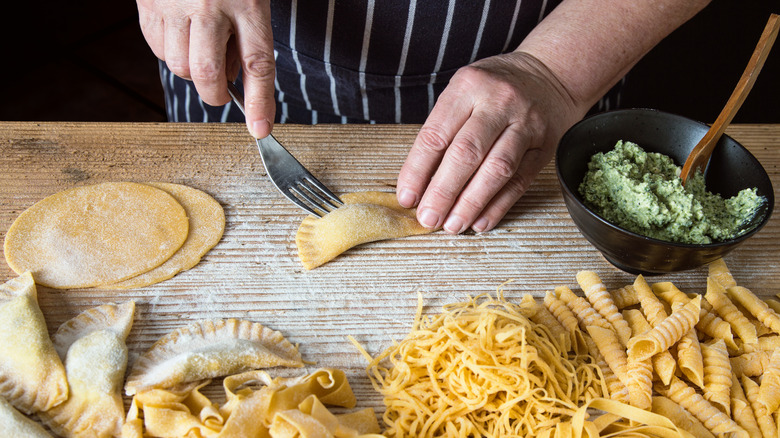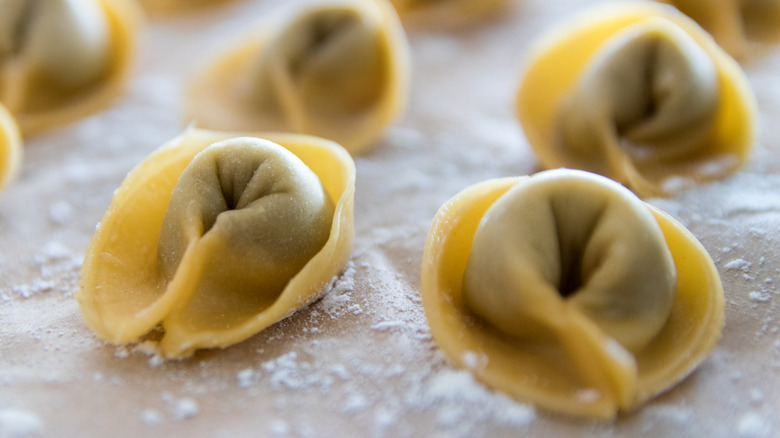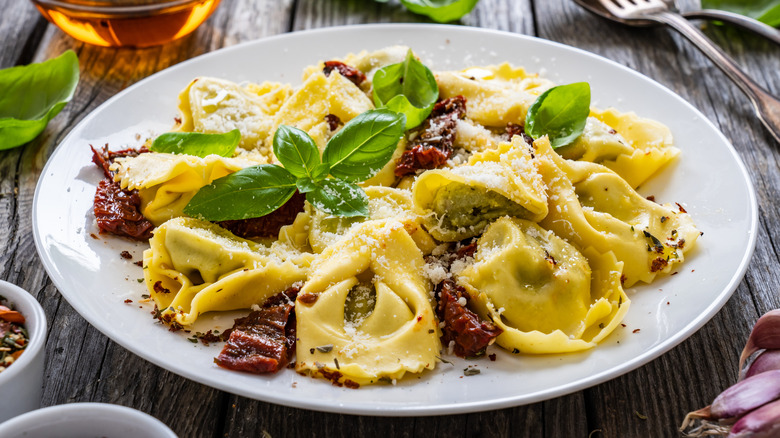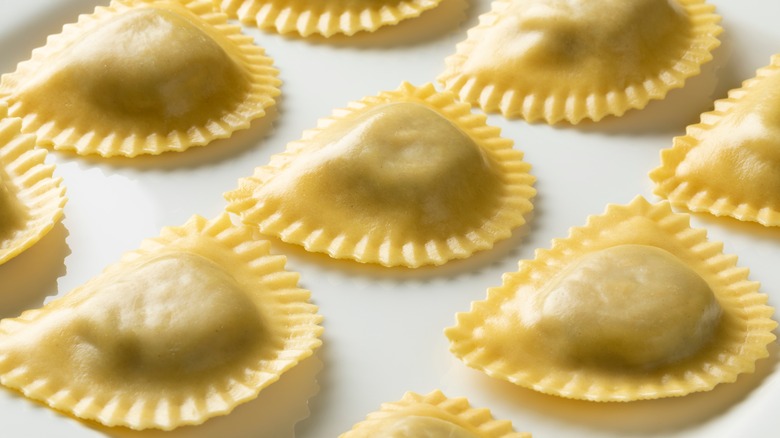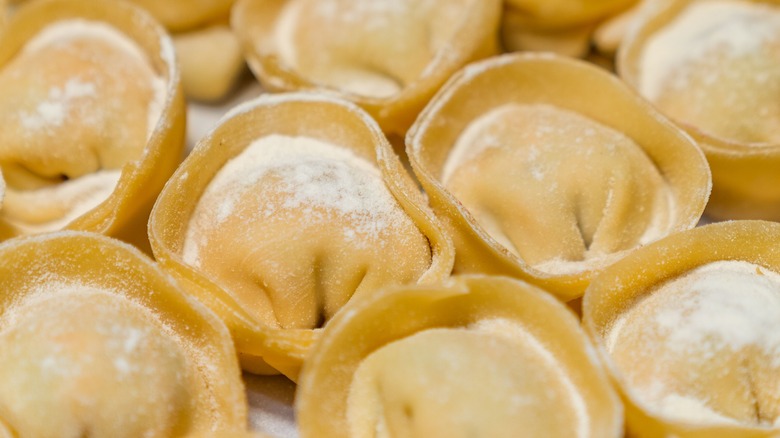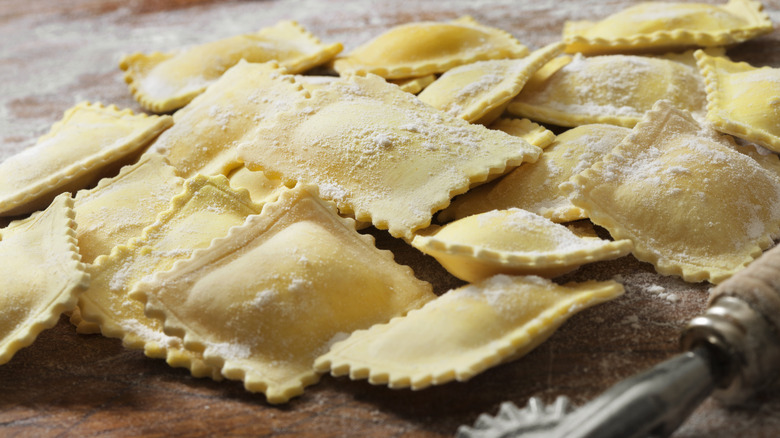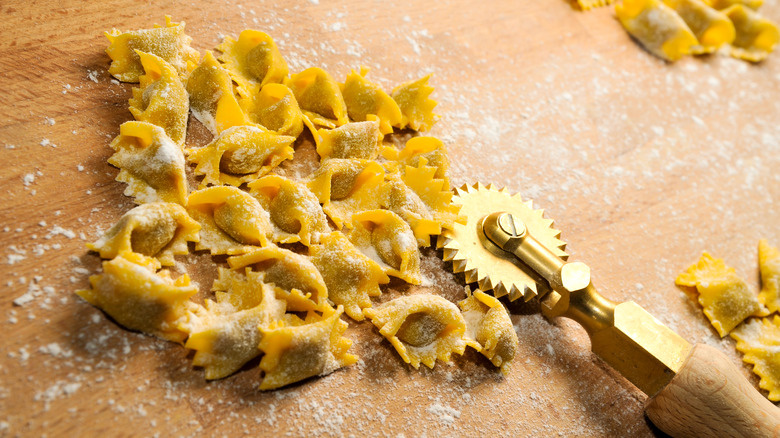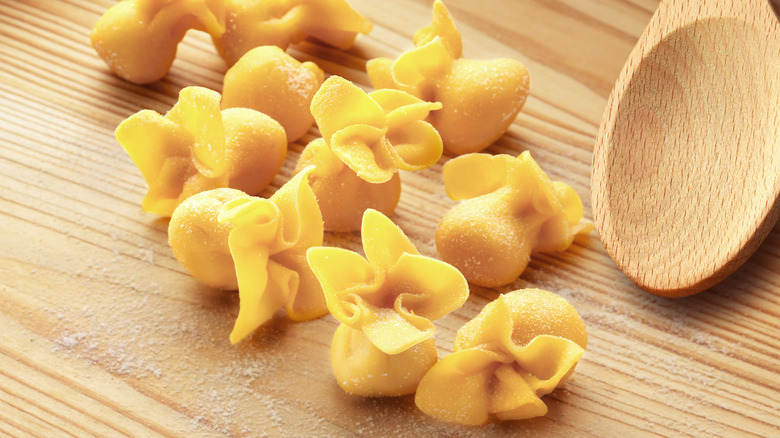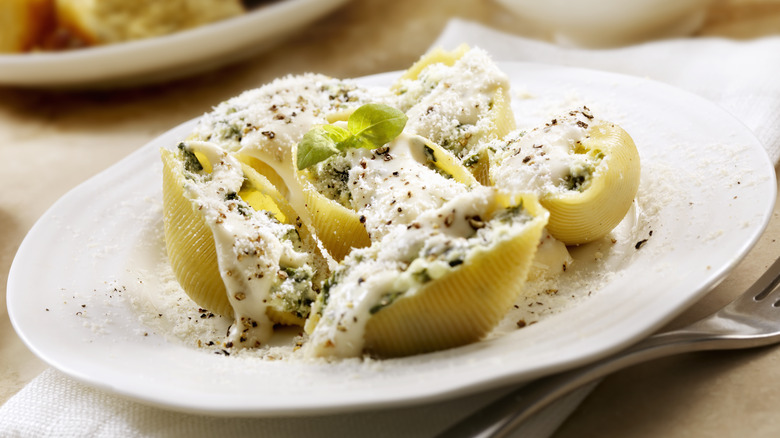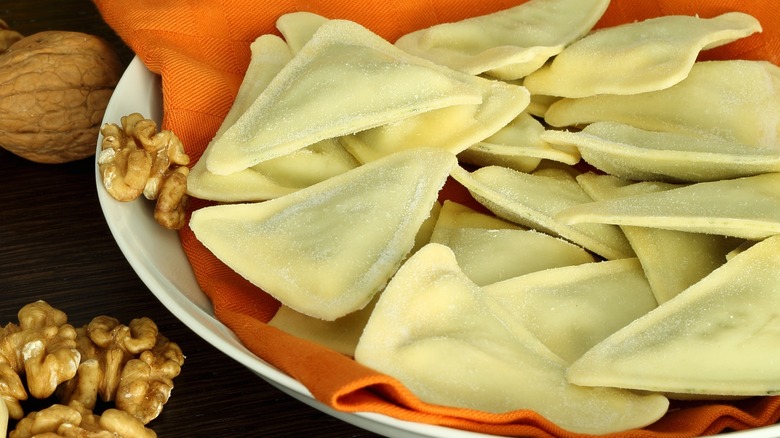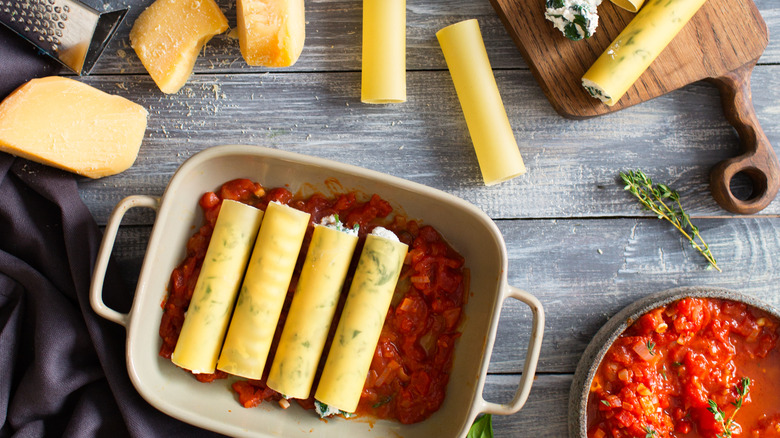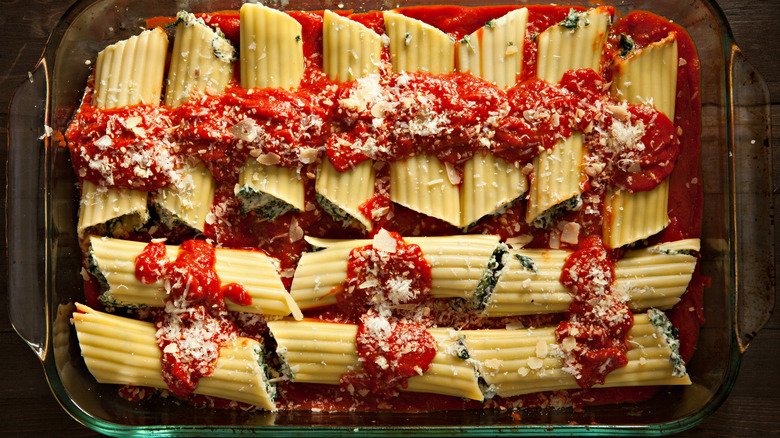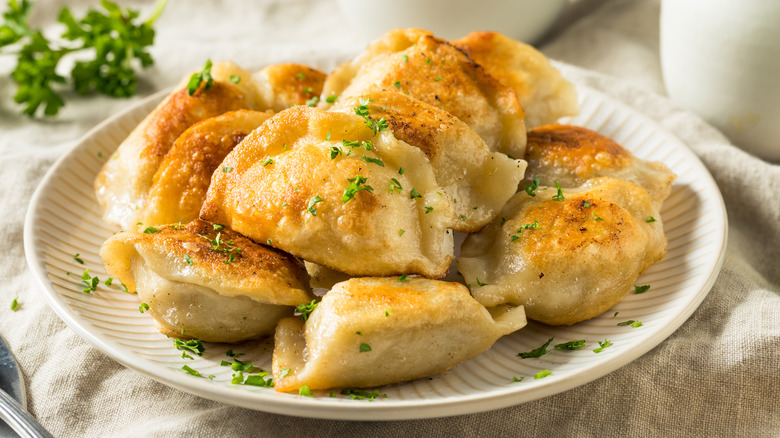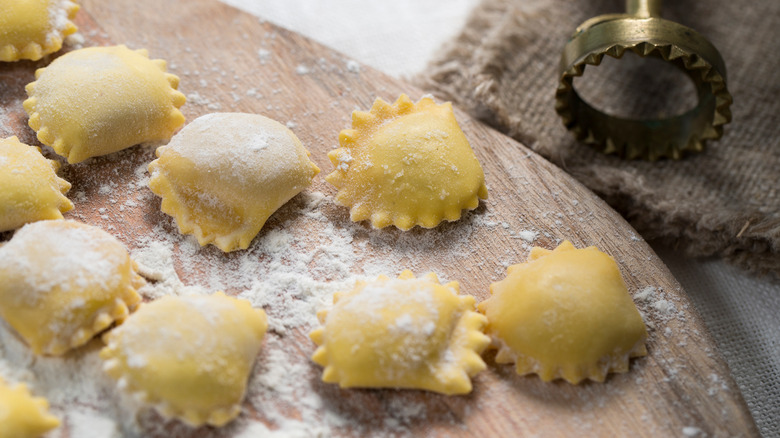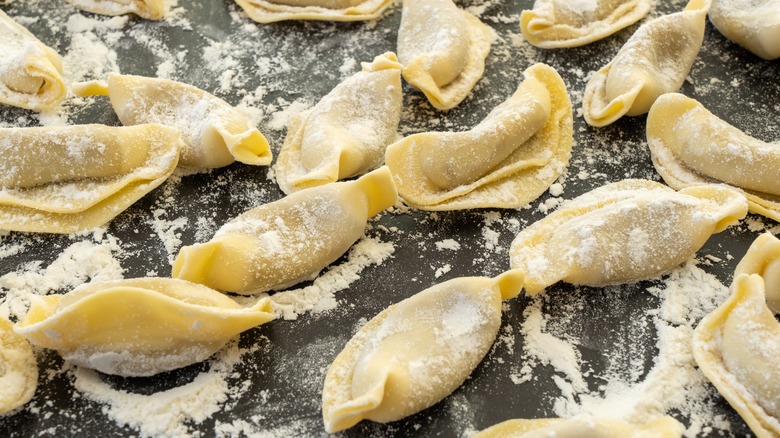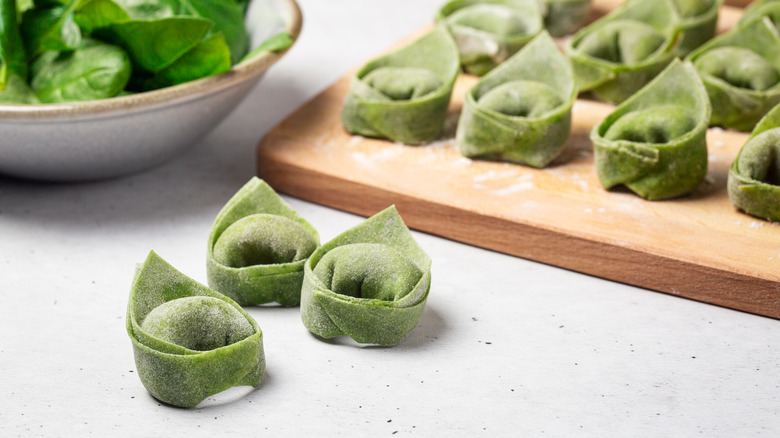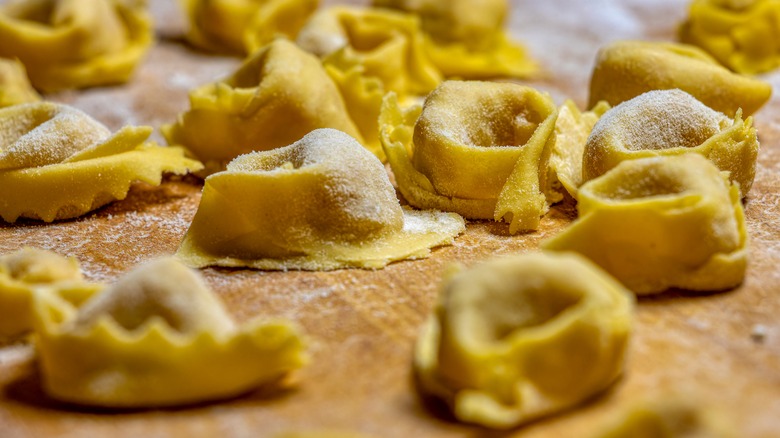16 Stuffed Pastas To Know And Cook
While ravioli and tortellini are the most commonly enjoyed stuffed pastas in the United States, there is a whole array of delicious stuffed pastas that you can easily make at home. From manicotti to mezzelune to agnolotti, knowing all the potential pasta options will give you a better understanding of what to cook and enjoy. And you can fill stuffed pasta with a whole lot more than just ricotta cheese — the possibilities are nearly limitless.
While most types of fresh stuffed pasta are reasonably simple to make, they require a bit of extra time and effort compared to boiling up a pot of noodles like spaghetti or angel hair. However, as is true with most things, the more effort you put in, the better it will turn out — and, well, the better it will taste. Keep reading to learn about 16 delicious stuffed pastas, what makes them unique, their origins, and the best types of fillings to use for each.
Tortellini
Tortellini, which means little pies, is a small ring-shaped stuffed pasta from the Emilia-Romagna region in Italy. The region includes Bologna (more cheese) and Modena, both of which claim to be the original birthplace. Either way, they are made from flattened dough squares ranging in size from 1 1/4 to 1 3/4 inches and are typically stuffed with parmesan cheese, egg, and ground meats such as prosciutto, pork loin, and mortadella. However, Bologna tortellini tends to contain more cheese than Modena recipes. Tortellini can also be filled with ricotta and parmesan cheese or shredded beef.
Whatever you decide to put inside your delicious tortellini, these pillowy bites of pasta are perfect for tossing in pesto, marinara, or alfredo and can also be served in soup. In addition, tortellini is traditionally cooked in meat stock, not water, to preserve the flavor of the filling and add a rich taste to the pasta dough itself.
Tortelloni
Often mistaken for tortellini, tortelloni is a medium-sized keyhole-shaped pasta. While tortelloni has a similar shape and name, it is larger than tortellini, allowing for more delicious filling. It is made with a round piece of dough folded in half over the desired filling. The ends are then twisted together to form their signature circular shape.
Popular in Northern Italy in the regions of Emilia-Romagna and Lombardy, tortelloni is typically served with a vegetarian filling like ricotta, pumpkin, or leafy greens like parsley and spinach. However, modern versions can contain just about anything you like, including lobster, artichokes, and other types of meat. Once prepped, they are boiled in water with a dash of salt. Regardless of the filling you use, tortelloni pairs perfectly with a sage butter sauce, pesto, tomato sauce, and more.
In Italy, tortelloni is a classic Christmas Eve pasta. While it is delicious any time of the year, this is a result of the Catholic church's recommendation to abstain from eating meat the day before Christmas. Thanks to tortelloni's primarily vegetarian filling, it has become a much-loved favorite on Christmas Eve.
Mezzelune
Mezzelune comes from the same family as ravioli. However, unlike its square cousin, it has a semi-circle shape. The dough is traditionally made with a mix of semolina and buckwheat flour, but contemporary renditions use other kinds of flour, including gluten-free options. Regardless of the flour, the dough is flattened and cut into round pieces. The circular dough is then filled, folded in half, and sealed with a pinked or ridged border on one side, giving it a bit of added texture and aesthetic appeal.
The word mezzelune is derived from the Italian word for half moons, hence the shape of these tasty stuffed pasta pockets. They are a staple of Northern Italian cuisine, but the recipe is so well-loved it now traverses national borders and has become common in parts of Germany, where it is filled with shredded cabbage. In Italy, mezzelune is commonly stuffed with ricotta cheese or spinach, but meat also makes an excellent filling. Some regions even use beets.
Once prepped, mezzelune is most often boiled, but they also make excellent fried treats as well. Best of all, the versatility and generous amount of filling allow you to use any pasta sauce you like. When fried, make sure to salt them as soon as they come out of the oil to ensure the granules stick to the shells before they have a chance to cool and become less absorbent.
Cappelletti
Cappelletti, or little cap in Italian, is thought to be named after the Spanish soldiers' pointed hats from the 1600s. It is generally the size of a quail egg and is considered a pasta dumpling. While the cut of dough and shape of the formed pasta pocket is similar to tortellini, it usually contains a ricotta or parmesan reggiano cheese filling, making it more similar to tortelloni.
Similar to other dumpling-style stuffed pastas, cappelletti makes a great addition to soups and broths. It is also popular boiled and served tossed in various pasta sauces. If you choose to serve them with a cheese-based sauce, like alfredo or gorgonzola, make sure the cheese filling you use complements the flavors of the sauce and doesn't become too rich.
Cappelletti was conceived in the northern Italian region of Emilia-Romagna, and it is particularly prevalent in Bologna and Modena. Additionally, it was believed to be a food reserved for the elite in Romagna for many years, and once you try a decadent morsel, you'll see why. In Italy, it is a popular Christmas pasta enjoyed with family and in times of celebration.
Ravioli
Widely thought of as the most well-known type of stuffed pasta in Italy and the United States, ravioli is loved the world over. While ravioli is a northern Italian tradition, many regions have their own beloved recipes due to its popularity. Traditional ravioli come in small square or circular pockets stuffed with an array of fillings. Variations on this much-loved stuffed pasta include ravioletti, which is smaller, ravioli gigante, and ravioloni, both of which are larger.
These delicious pillowy stuffed pastas are made with two sheets of thinly rolled pasta dough brushed with an egg wash and placed on top of the other with filling in the middle. The edges are then crimped or sealed into pockets.
For the filling, ricotta cheese and meat are the traditional favorites. However, all kinds of vegetables, seafood, and other ingredients have found their place inside these delicious pasta dumplings. From lobster to spinach to pumpkin to mushrooms to butternut squash, you really can't go wrong. When made without meat, ravioli are often enjoyed by practicing Italian Catholics during Lent. Regardless of the filling, they are also commonly made and enjoyed for special occasions like Christmas.
Ravioli cooks quickly in just three or four minutes. Conveniently, the pieces start to float in the boiling water when they are done, making it easy to monitor and cook to al dente perfection. Pro tip: Don't let the water exceed a low simmer, or the ravioli will likely burst.
Agnolotti
Agnolotti is small and rectangular or semi-circular in shape and features a ridged edge. While they are closely related to ravioli, agnolotti only uses a single layer of dough folded over filling. In contrast, ravioli uses two sheets of dough and is cut on all sides. They originate from the Piedmont region in northern Italy and are particularly popular in the provinces of Alessandria, Monferrato, and Asti.
For bite-sized convenience, agnolotti stuffed pasta is made using 2-inch squares of dough. They are almost always filled with roasted meat, like ground beef or pork, but you can also fill them with cheese, and vegetables, just like ravioli. Many chefs choose their filling based on what ingredients they have available or need to use quickly, so you're likely to come across agnolotti filled with mushroom, pumpkin, or butternut squash as well.
Agnolotti is traditionally cooked in a meat broth and served with a meat sauce. They can also be boiled in water with salt and are commonly served with a light cream or browned butter and sage sauce, like agnolotti di zucca with seasonal squash. Whatever you decide, these fresh pasta pouches only take about two or three minutes to cook and float in the pot when ready.
Fagottini
Made to resemble tiny purses, fagottini stuffed pasta has the ability to hold a considerable amount of filling. They are formed with a square piece of pasta dough that is gathered and cinched at the top like a pouch, giving it a signature, distinct form. While the name means little bundle, in today's world, it can feel a bit jarring and somewhat derogatory to say, so many people choose to refer to them by one of their other names; sachetti or fiochetti. No matter what you call them, they are scrumptious.
Fagottini comes from the Lombardy and Emilia Romagna regions in Italy and is typically stuffed with vegetables, savory ingredients, and cheese. Ricotta with carrots and green beans is one of the most common filling concoctions. Truffle and pear are also popular filling ingredients. When mixing your filling of choice, avoid using a lot of oil, or it can sink to the bottom of the pouch and lead to uneven textures throughout the purse.
These delectable pasta purses pair well with thin sauces and in savory broths. Grana padano and parmesan reggiano sauces are the most common in the regions from which fagottini originates.
Conchiglie (stuffed shells)
Popular and versatile, conchiglie comes in a range of sizes, the largest of which are ideal for stuffing with blended cheeses like ricotta or cottage cheese and spinach. They are boiled, stuffed, and baked with sauce on top to create a hearty casserole-style dish, like lasagna. You may also be familiar with smaller versions used with shells and cheese recipes and various soups, like minestrone.
The name of the pasta means shells, and in fact, that is what they are most commonly called and labeled as in the United States. They are conch-shaped and have either a smooth or ridged surface. When ridged, they do an excellent job of retaining sauce. To help the shell shape hold up better during cooking, they are typically made with hard durum wheat.
While most people refer to all sizes of this pasta as conchiglie, the largest size, which we stuff, is technically called conchiglioni. Conchiglie refers to the medium-sized version and is best with rich sauces. The smallest is called conchigliette and is excellent for soups.
Pansotti
Pansotti looks a lot like ravioli, but instead of having a square shape, it is triangular. The pillowy pieces are created using a single layer of thinly rolled pasta cut into squares. The squares are then folded over from corner to corner, forming a triangle. It can have smooth or pinked edges.
Aside from the shape, it traditionally features a filling made from a blend of herbs, egg, ricotta, spinach, and Swiss chard or other greens. The most typical spices include marjoram and nutmeg, but some chefs only use one. Pro tip: When making the filling, make sure to remove as much liquid from the boiled greens as possible before mixing it with the other filling ingredients.
The most common sauce served with pansotti is a savory walnut sauce, similar to a pesto. Hazelnut sauce is also popular because of its smooth nutty flavor, which perfectly compliments the greens in the filling.
Pansotti originated in the Liguria region on the Italian Riviera in the Northwest part of the country. The first mention of the pansotti with walnut sauce in print wasn't until 1931, making it a relatively new recipe compared to other kinds of stuffed pastas. Even so, its unique filling and sauce made it an instant crowd-pleaser. Similar to other primarily vegetarian stuffed pastas, pansotti is popular in Italy during Lent and on Christmas Eve when practicing Catholics abstain from eating meat.
Cannelloni
Similar to manicotti, cannelloni originated in the Italian region of Emilia. Compared to manicotti, cannelloni is typically broader and shorter. However, many people say the two kinds of pastas are essentially interchangeable.
This rich stuffed pasta consists of sheets of smooth pasta wrapped around a filling of rich ground meat, bechamel, and tomato sauce to create tubes. Other popular filling options include ricotta and spinach, ground beef, veal, pork, mushrooms, and shredded carrots with diced celery. Whichever filling you decide to use, the pasta tubes are traditionally baked and topped with a cream or bechamel sauce and a dollop of red sauce.
The pasta is typically made into large tubes or cylinders using 3-by-4-inch rectangles that are the width of a dime. You can also use rolled-up lasagna noodles. When making from scratch, semolina flour should be used to help the pasta retain a bit of texture and bite, which counterbalances the soft filling. Balancing the liquid and solid components of the dish is also essential in maintaining a soft and creamy texture, especially after baking. Heating the pasta in the oven can dry out the pasta dough, but covering the cannelloni with ample sauce can help prevent this.
Manicotti
Manicotti, which means little sleeves, is made with large tubes or cylinders stuffed with cheesy ricotta and mozzarella, spinach and cheese, or meat filling. Once assembled, it is smothered in sauce and possibly more cheese and baked to bubbly perfection. This delectable stuffed pasta makes a fantastic first course, side dish, or main course.
While manicotti is traditional in southern Italy, Emilia-Romagna, and Campania, it is also a well-known dish worldwide. It became popular in the United States in the mid-20th century due to a surge in Italian immigrants. In the U.S., the noodles can only be purchased in a dried pre-formed tube, but the traditional Italian form is more like a crepe rolled around the filling.
The only real difference between manicotti and cannelloni is the texture of the pasta. Canneloni is traditionally smooth, while manicotti tends to have a ridged exterior that helps hold the sauce. However, the names are truly interchangeable, and Italians would say that Americans call the stuffed pasta manicotti while they only refer to it as canneloni.
When making store-bought manicotti noodles, boil until al dente, drain, and rinse with cold water to prevent sticking and enable easier stuffing. In addition, always bake manicotti smothered in red sauce and with cheese on top. This helps prevent the pasta from becoming too dry. You can also cover the dish with foil after 10 minutes to prevent drying out the sauce.
Pierogi
The final stuffed pasta on our list is pierogi. Even though it's not Italian, like the rest of the stuffed pastas above, pierogies are a classic stuffed pasta from Poland that people worldwide have come to know and love. Interestingly, the word pierogi is already plural, even though people in the United States often refer to them as pierogies. The singular form is pierog.
Traditionally, pierogi contains mashed potato with cheddar or farmer's cheese, but they can be made with savory or sweet fillings. Adding onion, spiced meats, sauerkraut, or cabbage, to the potato mix is also very common. Some chefs also make dessert pierogi with fruits and berries. Authentic Polish recipes typically prepare pierogi with caramelized onion, sausage or bacon, melted butter, and sour cream.
Aside from the abundance of filling options, pierogi are pretty versatile when it comes to preparation. They can be boiled, sauteed, or fried. They also freeze well, so you can easily keep a stash on hand.
Anolini
Anolini is a small circular-shaped pasta stuffed with stewed beef. They are cut with an anolini stamp or pasta cutter, and while they can have round edges, they are typically serrated. It is most commonly prepared as anolini in brodo — which is a fancy way of saying in a meat-based broth.
The filling for anolini is made with lean beef that simmers on low for 16 to 36 hours. It is generally stewed with wine or a mix of carrots, celery, and onion, and the result is tender, juicy meat perfect for a savory stuffed pasta. The classic "in brodo" broth they are boiled in is made with slowly cooked beef and capon. When the two meaty elements combine, you get a savory, filling, melt-in-your-mouth soup perfect for special occasions.
Anolini is a fantastic example of how pasta became an icon of Italian culture. After all, families from Parma in the Emilia-Romagna region of Italy have been making it since the 12th century. Traditionally, it was reserved for holidays like Christmas and Easter, but you should feel free to indulge in its hearty goodness whenever you like. It may be somewhat labor-intensive to make, but its long-standing roots prove it is more than worth the extra time and effort.
Casoncelli
If you fancy yourself a lover of ravioli, something tells us you'll swoon over casoncelli. The two stuffed pastas are closely related, but casoncelli has a few key differences that make it stand out from the crowd. To start, casoncelli has a unique shape. Egg dough is formed into a triangular shape, like some other types of stuffed pasta, but the tops are folded down over the bulk of the pasta pillow. The resulting shape resembles a folded handkerchief or, some might even say, a candy wrapper.
Casoncelli's origins are somewhat disputed — both Bergamo and Brescia (of the Lombardy region) boast they are the birthplace of this unique pasta. As a result, the traditional fillings vary depending on which specific territory you are discussing. In Bergamo, salami, roasted beef, pears, raisins, lemon rind, and breadcrumbs are all common filling ingredients. Over in Brescia, beef is still a typical filling, but ingredients such as carrots, celery, red wine, and onions are also introduced to the mix. Regardless of the region, a butter and sage sauce is typical. Other regions in the same area also put a fun twist on the classic renditions by filling their casoncelli with spinach and mortadella. Suffice it to say that no matter your preferences, there's a casoncelli filling to suit your tastes.
Balanzoni
Balanzoni looks like tortelloni in size and shape (like tortellini but about two or three times bigger), but it has one distinct difference: The pasta dough is green. It gets its hue from the spinach used to create it. This oversized pillowy creation is typically filled with mascarpone or ricotta cheese and mortadella, but you'll also find variations with egg, ricotta, Parmigiano Reggiano, and spinach stuffed inside.
Unlike many other stuffed pastas on this list, balanzoni is relatively new. In fact, the recipe is thought to have originated as late as the 1980s or '90s in Bologna. The name balanzoni pays homage to the region in which it was created and a carnival mascot, Dr. Balanzone (because the shape of the pasta looks similar to his hat).
While balanzoni may not be steeped in tradition, its large pockets stuffed with tasty filling are expertly balanced by the herbaceous taste of the spinach dough. Thanks to the complex flavor combination, it pairs wonderfully with a sage and brown butter sauce. However, it also goes nicely with pesto, alfredo, and marinara. If you opt for a pre-made tomato sauce, make sure to use one of the store-bought pasta sauces celebrity chefs love to use to ensure optimal flavor throughout.
Marubini
Marubini is a well-loved stuffed pasta from Cremona. It dates back to the 1500s and is well-loved in the region where it was created. Marubini is shaped into little rounds with scalloped edges, similar to a tortellini. They are filled with meat and, of course, a bit of cheese. More specifically, melted beef marrow, eggs, Parmesan, and breadcrumbs are one common filling combination. Another consists of either veal, roast pork, or braised beef and Parmesan cheese and beef marrow.
Similar to anolini, marubini is typically cooked in a meat broth. However, it is then drained and served with Parmigiano Reggiano cheese and melted butter (at least traditionally). Thanks to the rich broth, the pasta dough retains ample flavor, so not much is needed in the way of sauce. Regardless, marubini is quite similar to anolini (because of the rich meat filling and "in brodo" preparation), but it puts a slightly different spin on things that give it lots of regional flair.
Unfortunately, marubini is not widely known outside of Italy. If you want to get a taste of this special stuffed pasta, you may have to travel to Cremona or make it yourself. You may be able to find it in a select few authentic restaurants, but don't count on it.

